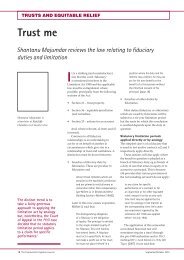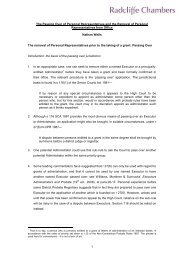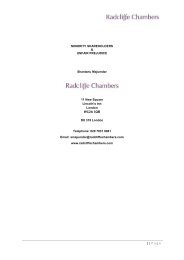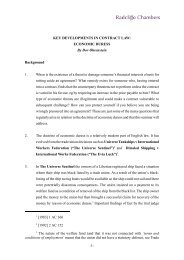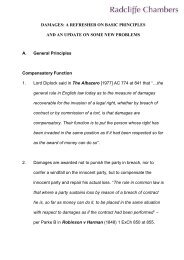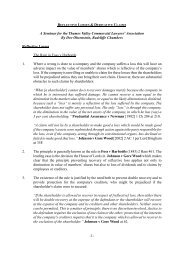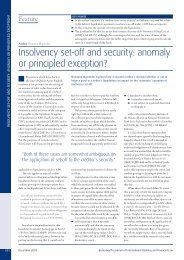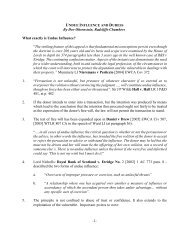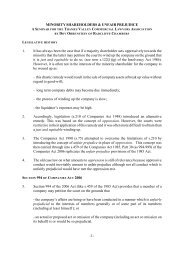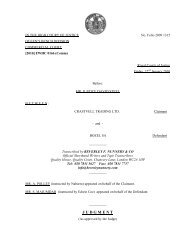Part 2 - Radcliffe Chambers
Part 2 - Radcliffe Chambers
Part 2 - Radcliffe Chambers
Create successful ePaper yourself
Turn your PDF publications into a flip-book with our unique Google optimized e-Paper software.
1054 LEGAL UPDATE SPECIALIST<br />
www.newlawjournal.co.uk | 24 July 2009 | New Law Journal<br />
666 the High Court of Australia<br />
explored the boundaries of the concept<br />
of the debtor’s assets: “But the debtor’s<br />
own moneys are not limited to his cash<br />
resources immediately available. They<br />
extend to moneys which he can procure<br />
by realization by sale or by mortgage or<br />
pledge of his assets within a relatively<br />
short time—relative to the nature<br />
and amount of the debts and to the<br />
circumstances, including the nature of<br />
the business, of the debtor.” Per Barwick<br />
CJ at 670.<br />
Balance of probabilities<br />
The burden of proof that the bankrupt<br />
was able to pay his debts on the date<br />
of the order lies upon the applicant<br />
for annulment and the standard is the<br />
normal civil balance of probabilities<br />
uncomplicated by the—discredited—<br />
notion of a sliding scale based on the<br />
gravity of any allegation of impropriety<br />
(see in Re B (Children) (Care Proceedings:<br />
Standard of Proof) (CAFCASS<br />
intervening) [2008] UKHL 35, [2009 1<br />
AC 11, [2008] All ER (D) 134 (Jun)).<br />
In Paulin it was held that where<br />
the applicant for annulment of a<br />
bankruptcy order made on a debtor’s<br />
petition establishes that there was<br />
no balance sheet insolvency, ie that<br />
his assets exceeded his liabilities, the<br />
evidential onus shifts to the debtor to<br />
establish commercial insolvency, ie<br />
that nevertheless he was unable to pay<br />
his debts. The existence of commercial<br />
insolvency in such a situation plainly<br />
requires an explanation and that<br />
explanation and the evidence to support<br />
it will lie more obviously in the hands of<br />
the bankrupt than the applicant.<br />
The court was also assisted by two<br />
authorities both from a family context but<br />
plainly of wider application in the sphere<br />
of bankruptcy.<br />
• The fi rst was Newton v Newton<br />
[1990] 1 FLR 33 where the husband<br />
had substantial assets but the wife’s<br />
evidence of his ability to raise the<br />
lump sum which she had been<br />
awarded at fi rst instance had been<br />
rather slender. The Court of Appeal<br />
held that absence of evidence as to his<br />
bankers’ probable or actual reaction<br />
to an application for a loan was a<br />
“glaring lacuna” which had justified<br />
the judge in taking the view that it<br />
was for the husband to lead evidence<br />
to show that he could not raise the<br />
money.<br />
• The second case was F v F (Divorce:<br />
Insolvency: Annulment of Bankruptcy<br />
Order) [1994] 1 FLR 359 on the<br />
approach of the court where the<br />
evidence in support of the debtor’s<br />
petition is less than full and frank. In<br />
ancillary relief proceedings, adverse<br />
inferences are drawn against parties<br />
whose evidence is similarly deficient<br />
and in Artman v Artman [1996] BPIR<br />
511 that principle was applied in<br />
annulment applications in the making<br />
of presumptions against “a debtor<br />
who prevaricates and fails to give a<br />
candid account of his affairs”. Phipson<br />
on Evidence opines that a rebuttable<br />
presumption is not the same thing as<br />
a shift of the evidential burden but<br />
as Wilson LJ so elegantly put it in<br />
Paulin “if not identical twins, the two<br />
concepts are surely first cousins.”<br />
On the facts of Paulin it was clear that<br />
the husband had attracted the evidential<br />
burden of showing that he could not pay<br />
his debts. He had made a substantially<br />
dishonest Statement of Affairs in which<br />
he had claimed inter alia that he had no<br />
interest in any freehold property, that he<br />
owned no property abroad and no shares<br />
and that he was living in the property<br />
owned by Cativo for a nominal rent.<br />
Findings<br />
On the judge’s findings these statements<br />
were quite untrue and the Court of<br />
Appeal was satisfied that the husband had<br />
neither discharged the evidential burden<br />
nor rebutted the presumption which arose<br />
against him. The judge had concluded<br />
that as at the time of the bankruptcy<br />
order the court would have varied the<br />
freezing order or that the husband could<br />
have obtained bridging finance in either<br />
case for the purpose of discharging his<br />
(genuine) debts. The Court of Appeal<br />
was rather sceptical about the second<br />
possibility but as to the first it decided<br />
that any uncertainty which it might have<br />
felt about the reaction of the court to the<br />
husband applying for a relaxation of the<br />
freezing injunction only arose because<br />
of his dishonest case in the court below<br />
that the assets in question were not his.<br />
If, instead, there had been an honest<br />
presentation of his affairs then the court<br />
would have been likely to co-operate.<br />
Discretion<br />
Finally, the question of discretion<br />
arose. In Artman v Artman it was said<br />
that: “The statute does not lay down<br />
any particular matters to be taken into<br />
account in the exercise of the court’s<br />
discretion, but the likely effect of any<br />
annulment order on the applicant, on the<br />
bankrupt where he is not the applicant,<br />
and on the bankrupt’s other creditors<br />
must, it seems to me, be among the<br />
most important matters to be taken into<br />
account. So must any element of abuse<br />
of process in the obtaining … of the<br />
bankruptcy order.” (Per Robert Walker J<br />
at 514B).<br />
Powerful reasons<br />
The husband’s nefarious motive for<br />
presenting his petition and the effect<br />
on the wife’s ancillary relief application<br />
of refusing to annul the bankruptcy<br />
were powerful reasons for exercising the<br />
discretion to annul but the judge had<br />
expressed the view that the annulment<br />
of the husband’s bankruptcy would<br />
have been “idle” because the husband’s<br />
creditors would then quickly petition<br />
for him to be made bankrupt again. The<br />
Court of Appeal disagreed; it would not<br />
be an idle exercise of the discretion if to<br />
do so would have enabled the judge to<br />
make the capital provision sought by the<br />
wife in her application for ancillary relief<br />
and to the extent that the judge may have<br />
thought that he could not do so because<br />
such an order would be at risk of being set<br />
aside as a transaction at an undervalue in<br />
any subsequent bankruptcy proceedings,<br />
then this fear was simply not justified in<br />
the light of the decision of the Court of<br />
Appeal in Hill v Haines [2007] EWCA<br />
Civ 1284, [2008] 1 FLR 1192, [2008] 2<br />
All ER 901.<br />
Even so, the interests of the husband’s<br />
genuine creditors were still relevant to the<br />
exercise of the discretion but quite apart<br />
from the fact that the wife seemed to have<br />
issued proceedings before the creditors<br />
had done so, where resources are scarce<br />
the family court will not always be able to<br />
make an order which allowed the husband<br />
to discharge his liabilities and it follows that<br />
in such situations the interests of creditors<br />
do not necessarily outweigh those of the<br />
wife. Accordingly, the judge had exercised<br />
his discretion correctly.<br />
NLJ<br />
Shantanu Majumdar is a barrister practising<br />
at <strong>Radcliffe</strong> <strong>Chambers</strong> in Lincoln’s Inn and<br />
appeared for the joint liquidators in Paulin<br />
v Paulin, instructed by Francis Wilks &<br />
Jones LLP. E-mail: SMajumdar@radcliff ech<br />
ambers.com



